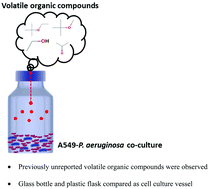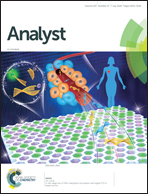Volatile organic compound signature from co-culture of lung epithelial cell line with Pseudomonas aeruginosa†
Abstract
Bacteria are found ubiquitously within and on nearly every site within humans, including the airways. Microbes interact with airway epithelial cells in lung infections such as ventilator-associated pneumonia (VAP). Development of infection results in the production of oxidants such as hydrogen peroxide that may further damage the epithelium. VAP is difficult to diagnose and associated with significant mortality. Current methods are invasive and time consuming impacting on appropriate therapy, antimicrobial resistance and financial costs. Volatile organic compound (VOC) analysis in exhaled breath is proposed as a tool for early detection due to its non-invasive property and potential to facilitate timely diagnosis. To investigate potential early VOC markers, A549 epithelial cells that were originally isolated from human alveoli were cultured with and without Pseudomonas aeruginosa, and the headspace of the culture vessel analysed using sorbent-based capture of VOCs followed by thermal desorption-gas chromatography-mass spectrometry (TD-GC-MS) in order to identify potential discriminatory VOCs. A549 cells were also cultured with hydrogen peroxide to induce oxidative stress in order to investigate potential biomarkers of epithelial cell damage. Previously reported VOCs including acetone and ethanol were observed from the infection experiment along with novel bacterial markers, which we identified as mostly ether based compounds. Alkanes such as decane and octane were also found to be elevated after hydrogen peroxide treatment of A549 cells, likely as a result of peroxidation of oleic acids.



 Please wait while we load your content...
Please wait while we load your content...